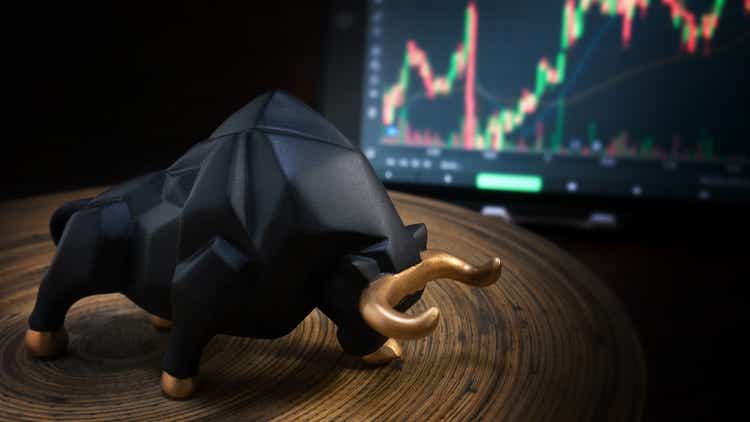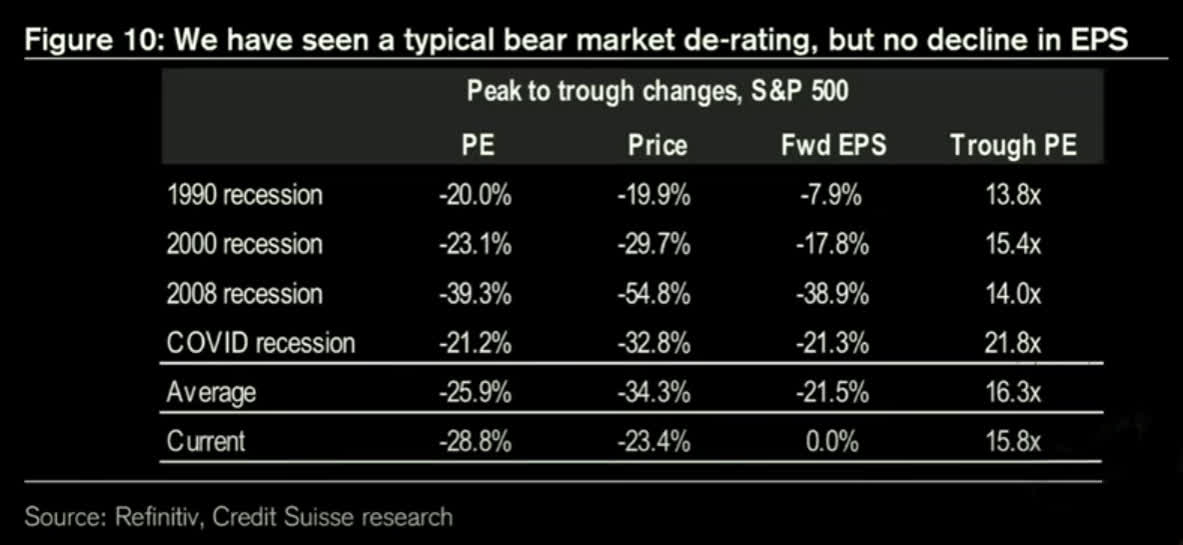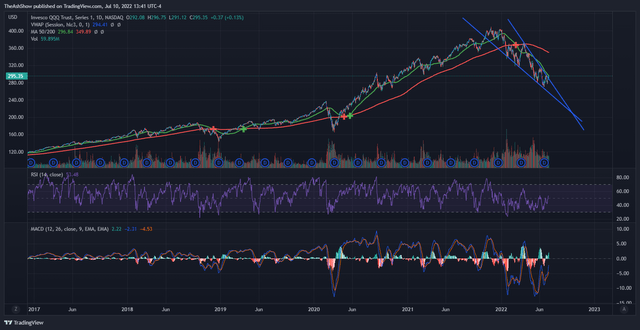Editor’s note: Seeking Alpha is proud to welcome The Ash Show as a new contributor. It’s easy to become a Seeking Alpha contributor and earn money for your best investment ideas. Active contributors also get free access to SA Premium. Click here to find out more »
niphon
Investment Thesis
I’m shocked and amazed by how many long-term investors are shying away from the stock market due to fears of recession and further market deterioration. Although swing traders and day traders do have reason to be concerned, long-term investors are being presented with a once-in-a-decade opportunity in my opinion.
Due to this market fear, which I will explain in great detail on why it is unjustified, the tech industry has had losses far surpassing the market average. This has been mostly due to supply chain issues and not inflation worries, and for this reason, my belief is that once these issues are alleviated (and they will be soon), the tech sector will experience a rally that we can capitalize on.
I believe that the heavily beaten down tech sector will be the fastest to rebound. Tesla’s (TSLA) recent move up more than 100 points, in only 5 days from July 5th to July 10th, is an early indication of this. According to my thesis, companies reliant on chips like NVIDIA Corp (NVDA) and Advanced Micro Devices (AMD) would be the quickest to bounce back. I however believe Invesco QQQ ETF (NASDAQ:QQQ) is the best buy on the market right now as it is a much more diversified and safer play that holds a good number of these major tech companies in its portfolio. In addition to the macroeconomic reasons stated above, there are also technical reasons you may want to invest in the ETF right now.
QQQ tracks the heavily tech-focused Nasdaq 100. Since this is an overall market play, we are likely to yield maximum results from full exposure to the tech market through QQQ while avoiding any risks associated with buying any one particular stock. Additionally, I will be going with Call Option LEAPS instead of common shares, as they provide a higher potential gain. LEAPS are long-dated options so I will not have to worry about theta decay as I plan to close out these positions for a sizeable gain as soon the supply issues are resolved, well before expiration.
But first, what is the QQQ
Very simply put, QQQ is an ETF offered by Invesco PowerShares that tracks the Nasdaq 100 Index since 2002. The Nasdaq 100 is a very tech-based index with the majority of its holdings (48.4%) allocated to the technology sector. The 4th most traded ETF in the world, QQQ has Assets under management (AUM) of $162.74 billion as of May 9, 2022. It is also very important to note that 51% of the index is comprised of 10 tech companies, as follows:
Apple (AAPL) 11.02%
Microsoft (MSFT) 9.98%
Amazon (AMZN) 7.83%
Tesla Inc. (TSLA) 4.53%
Alphabet C Shares (GOOG) 4.02%
Meta A Shares (META) 3.81%
Alphabet A Shares (GOOGL) 3.75%
Nvidia Corp. (NVDA) 3.71%
PayPal Inc. (PYPL) 2.19%
Adobe Systems (ADBE) 1.97%
So it’s very safe to assume that QQQ will move alongside the tech industry.
Why is the market currently fearful
To understand why investors on the sidelines are fearful, the recently deleted Dr. Michael Burry Tweet is the perfect example. In the tweet, Dr. Burry mentioned that we are halfway through with the pain. What Dr. Burry meant by that is that usually company valuations are calculated using 2 main metrics – EPS and P/E Ratio.
P/E x EPS = Company Valuation
Due to inflation fears, P/E multiples have been compressed, as investors are not willing to pay higher multiples given recession concerns – with an average reduction of 28.8% in P/E versus the average 25.9% reduction in P/E that happens during bear markets.
This brings us to the second half of the equation which is the EPS. Since the Federal Reserve is increasing interest rates to crush demand and bring inflation under control, earnings will start decreasing along with demand. So far the average EPS has not changed since the market crash.
Using this it’s easy to see why Dr. Burry believes we are halfway through the stock market crash. It appears that Credit Suisse’s report also echoes the same concerns.
Credit Suisse
But how does this halfway point translate in terms of percentages? In the case of the QQQ, it means we can expect a further 15-20% reduction in its current prices. It’s also important to note that the ETF is currently down 33.9% from its all-time high of $409.
A common concern is a time required for stocks to recover their highs, especially since stocks like AMZN took up to 10 years to reach their highs after the 2001 crash. But we can easily counter that argument via the following points.
-
ETFs like QQQ do not take 10 years to rebound. In most cases, the median is 2.5 years.
-
These comparisons are done by comparing all-time highs to the bear market low. While we do not know where the bottom is, by all estimations we are not remotely close to the highs. Therefore, at this stage of the market, this argument is not relevant.
As you can surmise, my main point here is that they are not considering any other factors outside of balance sheets. At present, there are macro/external factors – such as the Russia-Ukraine war and supply chain issues originating from China – that are also affecting the market.
External Factors
These events have massively impacted the supply side of the equation causing inflation for several reasons. First of all, Russia and Ukraine are among the biggest suppliers of wheat. As a result of this war, food shortages are occurring, resulting in skyrocketing commodity prices. Secondly, sanctions on Russia have caused a gas shortage which in turn has increased production prices, resulting in inflation. Lastly, China is still not shipping at its full capacity whether that is politically motivated or a result of backlogs from COVID-19 shutdowns.
In combination, these factors have taken a heavy toll on the market and, more importantly, on the supply side of the equation. However, these are all tied to the Russian invasion of Ukraine. It’s important to note that many political analysts expect a resolution in the next few months and with the pressure of an upcoming US election, an end may come sooner rather than later.
Once the war is resolved, the supply issues will also abate, allowing the Federal Reserve to ease or stop rate hikes altogether. This will allow demand to increase, and earnings would not be affected as much as people expect them to be. However, just as we cannot time the bottom (it is simply impossible: a lot of people have tried and failed, including Dr. Burry who self-admittedly was very early on his real estate market short play), we also cannot definitively know when a major war will end. But considering the global toll, I believe that elected officials will be motivated to come to the table to find a solution as the situation becomes increasingly untenable.
Technical Analysis
On the daily chart, two trendlines have formed a falling wedge. These lines have been tested multiple times and have stood the test of time. Last week we finally broke out of the wedge and it’s a very bullish sign that multiple candles have opened and closed above the trendline.
The QQQ has also hit and is currently testing the 50MA which is coinciding with the release of CPI numbers next week. There has not been a hard rejection of the 50MA but there may be a small sell-off before the CPI numbers are released. But I expect another attempt to break through the 50MA after the numbers are out.
I’m basing this on the decrease in demand shown in the latest manufacturing data for this month. Therefore, I expect that the CPI data will be in line with expectations or a slight beat – triggering the next run-up and a break of the 50MA. This will be confirmation of the QQQ’s breakout from the falling wedge.
Even the worst-case scenario is not so bad
On the other hand, if Dr. Burry is right, at worst the market will see a further 15-20% reduction in stock prices. But even he acknowledges that we are in the final leg. Although we might not know when the war will end, I believe that taking a starter position now – ideally with not more than 20% of your intended budget – will pay off for long-term investors.
Based on my earlier calculation, the worst case scenario should be no more than a 20% drop. Since we cannot time the bottom, and we don’t know if it will be a 5%, 10%, or the full 20% drop, this position allows us enough buying power to average down, should the market continue to fall. Ideally one should add more with every 5% drop. But by buying at current prices, investors will not miss the eventual run which could be triggered overnight once the Russia-Ukraine war comes to an end.
Possible risks associated with QQQ
As with anything we trade there are associated risks, and understanding those risks are key to minimizing or even eliminating them completely. A pronounced risk with QQQ is, as previously discussed, the ETF is heavily comprised of a few stocks, which means that if one company has bad news it can heavily skew the QQQ price even if the tech industry is doing well.
While that may be true, it will only decrease possible gains but not invalidate the trade, even with the top 4 tech stocks making up the majority of the ETF’s allocation, they are not heavily correlated in the sense that a chip shortage, for example, can affect NVDA and TSLA but not MSFT.
Conclusion
With the QQQ favoring the heavily beaten down tech sector and the expectations that it is the first sector to rebound, it is the best tool to use to take advantage of that rebound.
My favorite tool for this situation would be LEAPS. I favor QQQ call options at a strike of 300 expiring May 2023. Based on investors’ risk tolerance, 300 strike calls with an expiry date of January 2023 are also an option. As a hedge, I recommend adding QQQ puts at a strike price of 240 with the same expiry date for a Call to Put ratio of 3:1.
Again, I believe we are very lucky to be in the position we are in right now as this is an excellent once-in-a-lifetime opportunity. With some calculated risk, long-term investors stand to make a very high ROI.



Be the first to comment